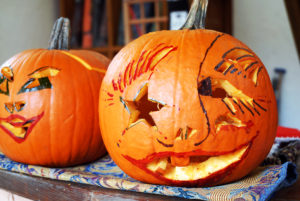Few people today will be aware of the centuries of history behind the modern commemoration of Halloween on 31st October. As with a number of ancient traditions, the celebration of Halloween has been hijacked by commercial interests, so that these days our shops are awash with fancy dress costumes, ghoulish decorations and themed foods and sweets.

In fact, many Halloween traditions are said to date back to Celtic times and can be linked to harvest festivals and the beginning of the darker time of the year, particularly the Gaelic festival known as Samhain. This celebration may have been adapted by the early Christian Church to become the feast of All Hallows’ Day, the time set aside to remember the dead, and particularly saints and martyrs to the cause of Christianity. A hallow in old English referred to a holy person, or saint, and so All Hallows’ Eve, or the day before the main feast day, became corrupted to Hallowe’en or Halloween.
As for the modern symbols and customs surrounding Halloween, many of these can also be traced back to ancient times. Offerings of food and crops were left outside homes to welcome spirits and fairies, and extra places at the dinner table were set to welcome the souls of the dead. Added to this was the tradition of `souling’, when children and poor people would go from door to door asking for ‘souls’, or small round cakes, in return for praying for the souls of the household and their friends.
From the Middle Ages, particularly in Scotland, Ireland and Wales, people would go from house to house in costume, reciting verses or songs in exchange for food. It could be that these costumes impersonated or represented the souls of the dead. Donating food items was said to bring good luck, whereas refusal would bring misfortune. From this, it is easy to see how the modern tradition of ‘trick or treating’ evolved, as well as wearing fancy dress and attending ghost and ghoul-themed parties.
Carving out the inside of pumpkins, or turnips in Britain and Ireland, and replacing the flesh with a candle also dates back many centuries. Atmospheric ghostly lights can sometimes be seen dancing over peat bogs or marshes at night time, and an Irish folk tale relates how these lights represent souls that have been denied entry to both heaven and hell. Known as jack-o-lanterns, and now transformed into pumpkin lamps, these lights evolved to becoming symbols to ward off evil spirits, and are now carried around at Halloween or left outside the home.
Although practised less often these days, the tradition of apple-bobbing in a bowl or tub of water can be traced back to the 17th century. Another game involved hanging up a treacle or syrup covered apple by a string, which the participant would try to eat without using their hands. Many of these practices were related to fortune-telling, particularly regarding death, marriage and children.
While society may have moved on from the original meaning of these Halloween rituals, the fact that they bring pleasure and a sense of fun to a gloomy time of year should be encouraged. And if Halloween traditions provide a link to our collective past, so much the better.





